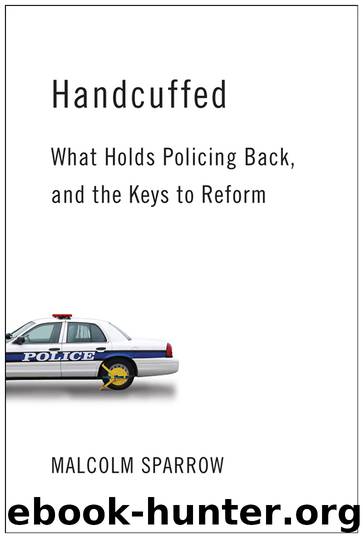Handcuffed by Malcolm K. Sparrow

Author:Malcolm K. Sparrow
Language: eng
Format: epub
ISBN: 9780815727828
Publisher: Brookings Institution Press
Published: 2016-03-24T16:00:00+00:00
Wrong Level of Focus
Social scientists focus on subtle effects at high (aggregate) levels; problem solving focuses on much more obvious effects but at lower levels. Social scientists (and economists) have tended to conduct macro-level analyses on aggregate data sets. They like to use sophisticated statistical methods on large data sets to reveal subtle correlations and causations between factors and outcomes. Inheriting these tendencies, EBP emphasizes the importance of evaluating the effect that particular programs (for example, DARE, early childhood intervention programs, or random patrols) might or might not have on overall crime rates or on some major category of crime rates (for example, violence), delinquency rates, or addiction rates later in life.
Problem solving, as taught by Goldstein, emphasizes careful disaggregation of broad crime categories, following the intuition that major crime problems have many parts (lower-level components) and that, usually, the various parts each behave differently and depend on different factors. Once the lower-level objects have been found (often through analysis), then each one can be studied and “unpicked.” In The Character of Harms, I have described how the art of navigating these lower-level strata of problems or harms is emerging as a vital professional skill for regulators and law enforcement:
The habits of mind . . . have something in common with the skills involved in a relatively mundane task: the undoing of knots. Give a knotted mass of string to an adult, who has developed all of the relevant cognitive skills (and maybe had some experience, too), and watch how they behave. Notice how they hold the whole object up to the light, and look at it this way, then that way, turning it around and around, examining it diligently from all sides—careful all the time not to pull or tug or to make matters worse—until they begin to understand the structure of the thing itself. As the structure of the knot becomes clearer, so the components or stages of a plan begin to form in their minds. . . . If they understood the structure correctly, and fashioned a plan accordingly, the knot eventually falls apart, and is no more.
In the regulatory field, we have a growing list of harms undone, knots untied, risk-concentrations eliminated or substantially mitigated. Invariably, the knots undone by regulators, or others who act in this vein, are not broad, general phenomena (at the level of “air pollution,” or “corruption,” or “motor vehicle accidents”). Nor are they minutiae, representing single incidents (of crime, or injury, or death). These knots untied, these harms undone, all lie in between, where the object of study is larger than a single incident or event, but smaller than a general class of harms. It is in this in-between realm where much exciting work seems to take place, amid the complex and multi-layered texture that connects individual incidents at the bottom to entire classes of risk (with their one- or two-word descriptions) at the top.9
Download
This site does not store any files on its server. We only index and link to content provided by other sites. Please contact the content providers to delete copyright contents if any and email us, we'll remove relevant links or contents immediately.
| General | Discrimination & Racism |
Nudge - Improving Decisions about Health, Wealth, and Happiness by Thaler Sunstein(7619)
iGen by Jean M. Twenge(5366)
The Fire Next Time by James Baldwin(5250)
Adulting by Kelly Williams Brown(4488)
The Hacking of the American Mind by Robert H. Lustig(4319)
The Sports Rules Book by Human Kinetics(4296)
The Ethical Slut by Janet W. Hardy(4175)
Captivate by Vanessa Van Edwards(3796)
Mummy Knew by Lisa James(3634)
In a Sunburned Country by Bill Bryson(3486)
The Worm at the Core by Sheldon Solomon(3435)
Ants Among Elephants by Sujatha Gidla(3417)
The 48 laws of power by Robert Greene & Joost Elffers(3026)
Suicide: A Study in Sociology by Emile Durkheim(2975)
The Slow Fix: Solve Problems, Work Smarter, and Live Better In a World Addicted to Speed by Carl Honore(2947)
Humans of New York by Brandon Stanton(2835)
The Tipping Point by Malcolm Gladwell(2828)
Handbook of Forensic Sociology and Psychology by Stephen J. Morewitz & Mark L. Goldstein(2660)
The Happy Hooker by Xaviera Hollander(2655)
